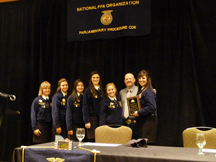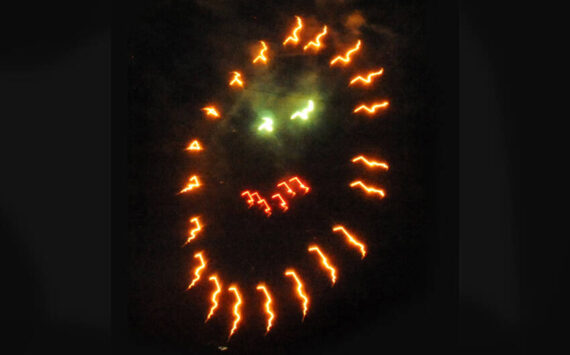
Tonasket’s FFA team, competing at the national convention in Indianapolis, finished second in national competition in Parliamentary Procedure in a three-day event against 43 other state champion teams. The team includes (front row, l-r) KB Kochsmeier, Hal
INDIANAPOLIS – The Tonasket FFA team’s state championship last May was only the beginning.
Six Tonasket High School students – five of whom graduated in June – proved they could compete with anyone in the nation Oct. 19-22 as they took national runner-up honors in the Parliamentary Procedure competition at the 84th National FFA Convention in Indianapolis.
“I can’t say I was planning on going to Indianapolis and nearly winning a national championship,” said Tonasket FFA coach Matt Deebach. “This is the first team I’ve been able to take back there. This is like dream-time stuff.”
Haley Bayless, Elizabeth Cleman, Haley Grillo, Kablina (KB) Kochsmeier, Flor Maldonado and Shelby Olma achieved something rarely accomplished by any Washington representatives at the National FFA (Future Farmers of America until 1988) Convention. Deebach said only six Washington FFA chapters have placed nationally in the event since 1978. Parliamentary Procedure is considered one of the most grueling of the 23 Career Development Events sponsored by the National FFA Foundation.
“It’s the longest-running, oldest and biggest speaking content of any that FFA offers,” Deebach said.
All but Kochsmeier graduated last spring, shortly after Tonasket FFA won the Washington state title to qualify for the national convention.
Tonasket’s Haley Bayless was also one of just seven out of 447 participants to earn a perfect score on the written exam on the first day of the competition.
“After we won state we wanted to make a legitimate run at the national title,” Bayless said. “As the summer went on we realized that we hadn’t been able to practice as much as other teams and that wasn’t realistic anymore. We went into competition with the mindset that we would do the best we could and hoped to make the first cut into the top 12.”
Reaching even that goal was a challenge. Only state champions qualified for the national convention; 44 states were represented, with the teams culled from more than 7,400 chapters nationwide. The 44 teams were divided into pools, with the top two from each pool advancing to the final 12. Tonasket was thrown in with three other teams – Missouri, Kansas and Texas – that were considered national title contenders.
Or, to borrow NCAA basketball tournament terminology, “It was like competing with three number one seeds,” Deebach said. “The talk was that we got a bad draw.”
Bad draw or not, Tonasket advanced to the round of 12, then survived its third day of competition to compete against California, Louisiana and Wyoming for the national title.
Nevada Union, California, won the national title.
“The finals were in front of 4,000 people, (with the kids) all miked up and on video,” Deebach said. “Ag teachers buy these videos then to teach future teams.”
“Each time we heard ‘Washington’ called out (to move on to the next round) tears flooded our eyes,” Bayless said. “It was an unreal experience. It was absolutely crazy to think that we were among the elite parliamentary procedure teams in the entire nation, not just our state, like we were used to.
“It was a surreal feeling, definitely overwhelming. I was speechless.”
The event opened with the written exam, the score of which followed the team through each of three levels of live competition.
At each level, each team member was required to execute an assigned motion, as well as make a second motion of their own choosing. All discussion had to pertain to the assigned motion, and each team member was required to answer an oral question about that assigned motion. Each also had three minutes of impromptu questions to answer, and the president and secretary (in Tonasket’s case, Bayless and Grillo) were required to complete minutes of the meeting.
If it sounds complex and hard to follow, it is, especially to those not well-versed in parliamentary procedure. For the Tonasket team to compete at that level, it required endless hours of studying the entirety Robert’s Rules of Order (the official 11th edition of which boasts 816 pages) and 18 weeks of packets of study material Deebach assigned.
“It made it interesting, with all but one of the kids having graduated, getting everyone together,” Deebach said. “A lot of the studying the kids had to do on their own, and when we got together we practiced our demonstration.”
It’s not how most people spend the entirety of their first summer after high school.
“People don’t realize how much sacrifice it takes to compete at that level,” Deebach said. “It’s incredible what these kids gave up to do this.”
Tonasket FFA’s road to nationals started in March, where it had to finish in the top two in district competition to qualify for the state convention. At state, Tonasket survived a sub-state round of 24 to qualify as won of the final eight teams, and in May claimed the state title to earn the trip to Indianapolis.
Deebach said that the newly-founded Tonasket FFA Alumni coordinated much of the fundraising, while the Tonasket School District provided additional funding.
“In order to do this, we decided that the kids’ job was to get ready to compete and try to win a national title,” Deebach said. “The alumni and the school supported that. It was extremely community-oriented and community-supported. We’re hoping we can do a public demonstration for the community in November, just to show people what we did and show our appreciation, because a lot of people don’t understand it.
“It was unbelievable kindness from our community, and unbelievable success from the kids.”
Deebach noted that, unlike high school sports competition, there were no classifications or allowances for teams sponsored by small schools competing against larger schools.
“It was an amazing feat no matter what size schools we were competing against,” he said. “But the California school, for example, has 2,200 kids in their high school and we have just over 300.
“It was just amazing to watch.”
“Reaching the national competition alone is quite an honor,” Bayless said. “Each round we passed was just icing on the cake and brought us even more joy knowing we made ourselves, Mr. Deebach, Tonasket and Washington State proud.”




